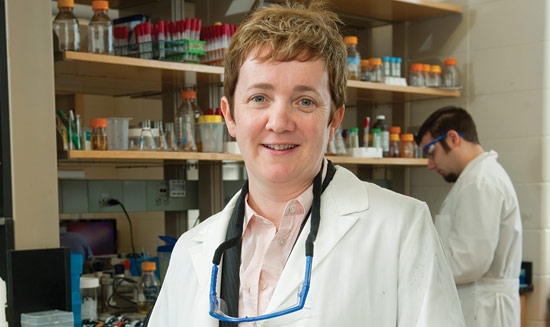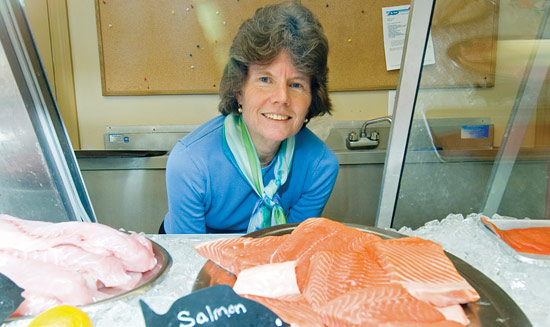
By tracey bryantOffice of Communications & Marketing

Microbiologist E. Fidelma Boyd wants to know how and why some members of Vibrio, a family of aquatic bacteria, cause illness and others do not.
Ultimately, her research could help advance new methods of screening seafood and drinking water for pathogenic Vibrio, and new ways to fight bacterial infection.
Boyd, an associate professor in the Department of Biological Sciences at UD, became intrigued by Vibrio years ago as a college student back home in Ireland. Sal-mon farms along Ireland's west coast were experiencing problems with bacterial infection, and that is where her studies began.
"These bacteria are natural inhabitants of the aquatic ecosystem, where they play important roles, such as breaking down chitin, a component of the shells of crabs and other sea life," Boyd remarks. "They are incidental human pathogens. However, there is concern about new pathogenic strains that can cause high mortality rates, particularly in individuals whose immune systems are already compromised."
Currently, Boyd is focusing on three species: Vibrio cholerae, Vibrio parahaemo-lyticus, and Vibrio vulnificus. Under the microscope, all look like curved capsules with a single flagellum, or tail. But genetically, each species possesses unique attributes that Boyd is investigating in the quest to understand how harmless microorganisms evolve to become harmful, even lethal.
Using the computer-intensive tools of genome sequencing and bioinformatics, she and her research group are illuminating these bacterial relatives at the molecular level. They are comparing the suite of genes of pathogenic and non-pathogenic isolates within each species and across the three species — as well as analyzing environmental factors — to find out what makes some microscopic "bugs" go bad.
Of particular interest to Boyd, the recent recipient of a prestigious National Science Foundation Early Career Development Award, is horizontal gene transfer, the delivery of genetic material from one species to another through the environment rather than from one species to its offspring.
Vibrio cholerae infects an estimated 3 million people annually, causing severe diarrhea and vomiting. According to the Centers for Disease Control, over 100,000 people die from the disease every year.
Pathogenic V. cholerae was confirmed in India in 1817 and began winding around the world in wave after wave of cholera pandemics. In fall 2010, it emerged in Haiti, causing the island nation's first cholera outbreak in at least a century.
Scientists previously pinpointed Vibrio Pathogenicity Island-1 (VPI-1) within the V. cholerae genome, where major virulence factors are encoded. Boyd and her group discovered a second pathogenicity island, VPI-2, harboring genes that break down sialic acid, an abundant amino-sugar on human mucous membranes. This unique trait allows the bacterium to use the compound as a food and energy source.
Additionally, Boyd and doctoral student Salvador Almagro-Moreno have identified three genes in VPI-2 that enhance the bacterium's survival in the human gut.
Boyd's group is examining how these island regions are acquired and integrated into the bacterial genome. Along with undergraduate student researcher Michael Napolitano, they have shown that some of these islands are new additions to the genome and others are much older.
While cholera has been around for centuries, a pandemic strain of Vibrio parahaemolyticus emerged only in the last few decades. Now, it is the leading cause of seafood-borne gastroenteritis worldwide, most frequently associated with the consumption of raw or undercooked seafood, particularly oysters and crabs.
Abundant in the warm waters of the U.S. Gulf Coast particularly in summer, V. parahaemolyticus has expanded its range to the Pacific Northwest likely due to climate change, according to Boyd, who is involved in a U.S. Department of Agriculture food biosafety study of the organism with Michelle Parent, assistant professor of medical technology, and Gary Richards at the USDA Agricultural Research Service (ARS) facility in Dover, Del.
"If a person eats fish or shellfish contaminated with V. parahaemolyticus, the organism can double its numbers in as few as 10 minutes," Boyd says.
The team has found four pathogenicity islands specific to the pandemic strain and used the information to create a PCR assay to rapidly detect it. Boyd and doctoral student Brian Whitaker discovered a cluster of genes that enhances the ability of V. parahaemolyticus to grow in seawater of fluctuating salinity, as high as 10 percent salt content.
"This ability also seems to enhance the organism's capacity to withstand other environmental stresses such as pH and temperature perturbations," Boyd notes.
Vibrio vulnificus, found in marine sediments, oysters and other sea life, is causing increasing cases of wound infection and septicemia. It is the leading cause of death due to consumption of contaminated sea-food in the U.S., and also afflicts fish.
The UD team discovered a number of unique properties about this opportunistic pathogen such as the ability to both catabolize and synthesize sialic acid, which is being investigated with visiting researcher Joseph Kingston from Mysore, India.
With collaborators at Washington University in St. Louis, Boyd and doctoral student J. B. Lubin are comparing the genomes of clinical and environmental isolates of V. vulnificus. They have discovered that, depending on the strain, V. vulnificus will produce different types of sialic acid and decorate different areas with it, such as its outer capsule or its flagellum.
A pathogenic cell attempts to masquerade as a host cell so that it will not be recognized as an invader, which would trigger an immune response, Boyd explains.
"An influenza virus always changes its outer coat so that it's not recognized anymore. This is a marker we've started looking at in Vibrio species."
By elizabeth boyleCollege of Earth, Ocean, and Environment

Doris Hicks knows seafood. In her 30 years as the Delaware Sea Grant College Program's seafood technology specialist, she has worked to promote safe and healthy seafood among members of industry as well as the public. She has developed safe seafood training programs for everyone from school food service workers to health care providers. Most recently, she worked with a national seafood alliance to revise training manuals for seafood processors ahead of changes to the FDA's fish and fishery products hazard prevention guidelines.
Her signature public outreach events are seafood contests such as the crab cake and chowder cook-offs that draw hundreds of hungry visitors to UD's annual Coast Day. Whether you're ready to get competitive or just making dinner, Hicks has helpful tips to offer (see right) for the next time you purchase and store seafood.
Get Hicks' and Delaware Sea Grant's complete guide to safe seafood handling at www.deseagrant.org.